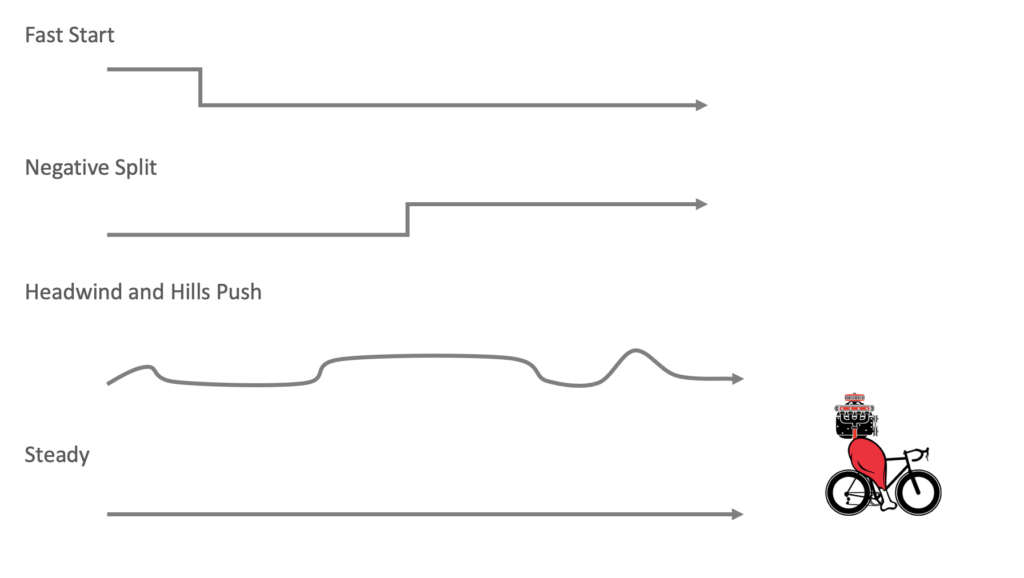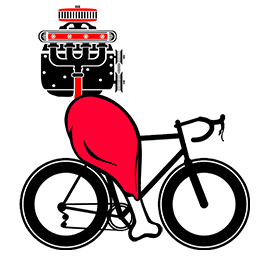How much should you vary your efforts in a cycling time trial?
Triathletes and time trial cyclists have often heard the pacing strategy, “Push more into a hill or a headwind.” Other wisdom includes, “Make sure you negative split.” But what do the data models say? Does surging into a higher aerobic zone or even into an anaerobic zone a cycling performance optimization strategy? Does starting fast or negative splitting help? TL;DR answer: For maximal speed, the longer the race, the less variation in your power output. In a shorter TT, varying power is a more effective strategy.
Study Summary

A recent scientific study looked at how variations in cycling power output over different race distances can impact performance times. The researchers used a mathematical model that simulated a 70 kg cyclist riding a 10 kg bike. They calculated the performance times for distances between 4 to 40 km with average power outputs of 200 to 600 watts. They also looked at how power fluctuations of 5 to 15% of the average power and frequencies of 2 to 32 power changes per race affected the times. They compared the impact of going out hard at the start (“fast-start” strategy) versus keeping a steady power (“constant-power” strategy).
The study found that for short 4 km races, varying power by up to 15% improved performance times by up to 0.90 seconds. However, for longer distances of 16.1 km up to 40 km, power variations of 15% slowed the modeled race times by 3.29 to 10.43 seconds compared to a steady power output. In other words, the more and bigger the changes in power were during the longer races, the worse the finishing times became.
The conclusions from this study are that endurance athletes should aim for stable power outputs during longer races to get the best performance. While initial “fast starts” or surges may help in short events, minimizing power fluctuations is key to optimal performance in endurance events, especially as the race distance increases. This is the best way to conserve energy and minimize fatigue while generating the fastest speed across the course. Anaerobic capacity g. Fatigue resistanceFor the best results over the course of a long cycling race, athletes should avoid excessive changes in power and instead stick as closely as possible to a consistent effort.
Training Peaks and WKO provide a metric called Variablity Index which divides your average power/nominal power. The closer those two number are together, the more consistent your power output. A 1.0 would mean 100% even power throughout the effort. The larger the VI, the more stochastic, or varied, the effort. View the Training Peaks VI article. Type of Ride
Steady workout (endurance ride) 1.00-1.02 Flat Road Race 1.00-1.06 Flat Time Trial 1.00-1.04 Hill-Climb Time Trial 1.00-1.06 Flat Criterium 1.00-1.06 Hilly Criterium 1.06-1.35 Hilly Road Race 1.20-1.35 Mountain Bike Race/Cyclocross Race 1.13-1.50
Do Your Own Experiment
Run your own long-course time trial tests on the same course on days with similar wind conditions. One day, push into headwinds and hills and the other day, lock onto a steady power no matter what the course throws at you. Compare times, RPE, and heart rate to each VI score. Attempt a similar test on a short-course and see how much varying your wattage on headwinds and hills helps. You can also test a fast start model or negative split model on each variant.
Abstract
Effects of magnitude and frequency of variations in external power output on simulated cycling time-trial performance
Published in Journal of Sports Sciences 2013
Abstract Mechanical models of cycling time-trial performance have indicated adverse effects of variations in external power output on overall performance times. Nevertheless, the precise influences of the magnitude and number of these variations over different distances of time trial are unclear. A hypothetical cyclist (body mass 70 kg, bicycle mass 10 kg) was studied using a mathematical model of cycling, which included the effects of acceleration. Performance times were modelled over distances of 4–40 km, mean power outputs of 200–600 W, power variation amplitudes of 5–15% and variation frequencies of 2–32 per time-trial. Effects of a “fast-start” strategy were compared with those of a constant-power strategy. Varying power improved 4-km performance at all power outputs, with the greatest improvement being 0.90 s for ± 15% power variation. For distances of 16.1, 20 and 40 km, varying power by ± 15% increased times by 3.29, 4.46 and 10.43 s respectively, suggesting that in long-duration cycling in constant environmental conditions, cyclists should strive to reduce power variation to maximize performance. The novel finding of the present study is that these effects are augmented with increasing event distance, amplitude and period of variation. These two latter factors reflect a poor adherence to a constant speed.
Authors
Marc S. Wells, G. Atkinson, S. Marwood

Jordan Fowler has experience as a head swimming coach of the Frisco Swim Team, a TAAF-awarded coach, a track and field distance running consultant for select Texas High School runners, and has competed as a triathlete, road runner, and cyclist. Though he is remarkably slower than he was in his 20s and 30s, he still enjoys endurance sports and sports science studies.
